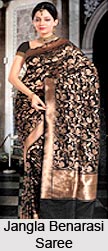 Banarasi sarees have a wide range of variation that is displayed in the creations of the artisans of Benaras. Banarasi Sarees are created with extraordinary concoction of exquisite weaving of Mughal era and Indian ethnicity; this is something that makes it the object of attention. Banarasi sarees are popular across the fashion world because of its intricate weaving. Banarasi sarees came into being during the Mughal era when Muslim artisans and craftsman chose Benaras as the place that blended well with their culture and started weaving silk Banarasi sarees. Banarasi Sarees are silk sarees designed with heavy gold brocade and its magnificent drape is flawless for the happy moments like weddings and other traditional occasions.
Banarasi sarees have a wide range of variation that is displayed in the creations of the artisans of Benaras. Banarasi Sarees are created with extraordinary concoction of exquisite weaving of Mughal era and Indian ethnicity; this is something that makes it the object of attention. Banarasi sarees are popular across the fashion world because of its intricate weaving. Banarasi sarees came into being during the Mughal era when Muslim artisans and craftsman chose Benaras as the place that blended well with their culture and started weaving silk Banarasi sarees. Banarasi Sarees are silk sarees designed with heavy gold brocade and its magnificent drape is flawless for the happy moments like weddings and other traditional occasions.
There are few varieties of Banarasi sarees and they are - Katan, Shattir, Organza (Kora) designed beautifully with zari and silk and finally Georgette. When segregated according to design process, Benarasi sarees can be divided into categories like Jangla, Tanchoi, Cutwork, Tissue and Butidar.
Katan
Katan is a plain fabric with woven pure silk threads which are twisted and woven into pure silk sarees. These pure silk sarees are now produced using power looms and rapid looms, while in ancient times Katan sarees were woven using handlooms with beautiful creation of patterns and motifs.
Shattir
 It is another fabric which is used in creating exclusive and contemporary designs of Banarasi sarees.
It is another fabric which is used in creating exclusive and contemporary designs of Banarasi sarees.
Organza (Kora) with Zari and silk
Brocades are most beautiful and richly woven fabric where the patterns are pattered with different designs made by warp and weft. Silver threads are coated with gold and are then woven closely around a silk yarn to create zari brocade.
Georgette
It is a finely woven light fabric with a simple and plain weave. This fabric is made of crepe yarn where two twisted yarns are inter-woven with both warp and weft. This fabric is most popular in modern types are used to produced designer sarees.
One can classify Banarasi sarees on the basis of different designs -
Jangla
 These styles of sarees are woven in colorful silk threads. The name of this saree derives from the pattern of design that distinguishes it from other Banarasi sarees. It has intricate Jangla patterns in form of Jangla vegetation motif that scrolls and spreads across the length of the saree. These sarees are believed to be ancient ones among Banarasi brocades. Unique designs and intricate detailing with luxurious fabric make this saree apt for wedding ceremonies.
These styles of sarees are woven in colorful silk threads. The name of this saree derives from the pattern of design that distinguishes it from other Banarasi sarees. It has intricate Jangla patterns in form of Jangla vegetation motif that scrolls and spreads across the length of the saree. These sarees are believed to be ancient ones among Banarasi brocades. Unique designs and intricate detailing with luxurious fabric make this saree apt for wedding ceremonies.
Tanchoi
Beautiful "Jamawar" style paisleys or Labyrinth woven by zari adds value to this silk saree making it appropriate for wedding ceremonies. Artisans from Benaras weave patterns on these sarees with colorful weft silk yarns. The pallu of this saree are often decorated with large motifs of paisleys while the border is beautified with criss-cross patterns.
Cut work Saree
These sarees are commonly referred as the less expensive version of Jamdani sarees. This type of sarees is prepared by cut work technique on plain texture. Silk Jamdani sari is produced by placing few warp threads with cotton and weft to produce traditional design patterns. Most popular motifs which are featured in cut work sarees are jasmine, marigold flowers, creepers and leaves. Unique patterns of cut work sarees are created from selvage to selvage which resembles the design of Jamdani.
Tissue Sarees
 Delicately woven sarees with golden zari weft adds sheen to these tissue sarees and therefore it is also known as the golden cloth. Most popular designs used in tissue sarees are golden zari woven lotus floating in a radiant pond, where the water drops are designed with cut-work technique. The border and pallu of the sari are patterned with self woven paisleys.
Delicately woven sarees with golden zari weft adds sheen to these tissue sarees and therefore it is also known as the golden cloth. Most popular designs used in tissue sarees are golden zari woven lotus floating in a radiant pond, where the water drops are designed with cut-work technique. The border and pallu of the sari are patterned with self woven paisleys.
Butidar Sari
Inimitable feature of Butidar sarees is that it is a richly woven sari which is brocaded with threads of gold, silver and silk. Gold is darker in shade as compared to silver threads. Therefore the weavers of Benaras refer to this variety of brocade patterning as Ganga-Yamuna. Motifs are locally popularized as Angoor Bail, Ashraffi Butti, Latiffa Butti, Reshem Butti Jhummar Butti, Jhari Butta, Patti Butti, Baluchar Butta and many more.





















